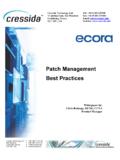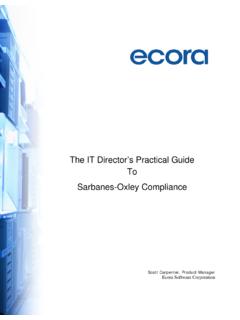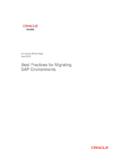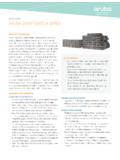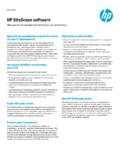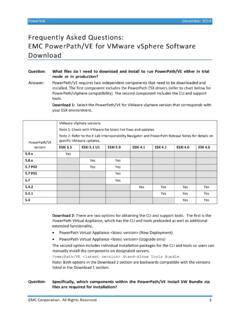Transcription of RepliWeb R-1 Installation and Setup Guide
1 RepliWeb R-1 Version Centralized One-To-Many Distribution System Over Dynamic IP Networks Installation and Setup Guide For Windows and UNIX operating systems RepliWeb , Inc. R-1 Version Setup & Installation Guide Copyright 2004 RepliWeb Inc., All Rights Reserved The information in this manual has been compiled with care, but RepliWeb , Inc. makes no warranties as to its accuracy or completeness. The software described herein may be changed or enhanced from time to time. This information does not constitute a commitment or representation by RepliWeb and is subject to change without notice. The software described in this document is furnished under license and may be used and/or copied only in accordance with the terms of this license and the End User License Agreement. No part of this manual may be reproduced or transmitted, in any form, by any means (electronic, photocopying, recording or otherwise) without the express written consent of RepliWeb , Inc.
2 Windows, Windows NT and Windows XP are trademarks of Microsoft Corporation in the US and/or other countries. UNIX is a registered trademark of Bell Laboratories licensed to X/OPEN. Any other product or company names referred to in this document may be the trademarks of their respective owners. Please direct correspondence or inquiries to: RepliWeb , Inc. 351 S Cypress Road, Suite 402 Pompano Beach, Florida 33060 USA Telephone: Fax: Sales & General Information: Documentation: Technical Support: Website: Table of Contents 1. R-1 User Installation 2. Installation Network E-Mail 3. Verifying Firewalls Windows Installation Command Line UNIX Unpacking the Installation Installing 4.
3 License Starting the R-1 Scheduler on the Updating 5. Testing Test Procedure UNIX Test Procedure UNIX Test Procedure Windows Test Procedure Windows 6. Activating 7. Uninstalling Uninstalling from Uninstalling from 1. Introduction Installation and Setup Guide for R-1 provides information about and instructions on how to implement the technical operating environment (system platform) described in the System Guide for R-1. R-1 is a centralized, high-level, one-to-many distribution system, engineered to perform in complex and dynamic IP networks (LAN, WAN, Internet, eCDN, Edge based, over Unicast and Multicast). R-1 provides unattended, Center-to-Edge data deployment and synchronization that scales in volume of data, number of processes and number of target machines, employing heterogeneous (cross-platform) server environments (Microsoft Windows , UNIX).
4 UploadDownloadDownloadDistributeEdgeEdge EdgeConsoleCenterEdgeEdgeEdgeEdge R-1 s flexible architecture allows the user to run distribution and replication jobs regardless of network configuration. The target system can also be a Network Attached Storage (NAS) server. Cross-platform synchronization (Windows to UNIX or vice versa) is supported. An R-1 job replicates between two computers: a Center computer containing at least the R-1 Center component and an Edge computer containing at least the R-1 Edge component. Numerous systems may be involved in a single distribution job. In such a Setup , one Center computer distributes data to multiple Edge computers. Introduction R-1 v. Installation Guide Each component is independent of the others, meaning that a given system can be a Center, Edge, or Console. The components that should be installed on a given system depend on the role that the system will fill in the replication and distribution topology.
5 Also, any given system can be of a different platform (Windows or UNIX), regardless of the role it plays or the R-1 components that are installed on it. For explanation about the roles of the R-1 components, see the Terminology chapter. For a complete explanation of the R-1 system, see the R-1 User Guide , referred to in the Reference chapter. Licensing Each server that is a part of the distribution process (Center or Edge) requires a unique license. The license enables the operation of both the Center and the Edge components. The Installation process installs a temporary 30 days license. The permanent license is delivered in the form of a text file to be copied into a license directory in the Installation . A server that needs only the Console functionality does not require a license. R-1 Security R-1 operates as a high level application. It does not run in Kernel mode. All the distribution processes are running in user mode, requiring user and password authentication from the system and thus their access is being restricted to what that user can access.
6 R-1 does not add accounts to the system and does not require privileges that bypass system security in any way. In addition, R-1 allows authenticated and encrypted data transfer of valuable digital assets between hosts. All access can be denied by default, unless specifically permitted. Trusted IP addresses, subnets, users and schedules are supported, as well as the total anonymity of user/password/directory information from one host to another, thus allowing for secure transport between untrusted networks. This authentication proxy mechanism adds a layer of autonomy, enabling hosts that do not trust each other to synchronize massive content stores without having to divulge anything beyond the machine name or IP address, virtual user and virtual password. User Authorization On Windows system, R-1 should be installed by a user with Administrator privileges. This is required in order to define the R-1 services. On Unix, R-1 must be installed by root so that TCP/IP services can be defined in the system configuration files.
7 3 R-1 v. Installation Guide Introduction Installation Location R-1 is a non-intrusive, high-level application - Installation on production servers does not require reboot or taking any application or user off-line. All application files are installed under the Installation target directory: Windows default directory is ~:\Program Files\ RepliWeb \ UNIX default directory is /usr/ RepliWeb / R-1 is not sensitive to the Installation location, and default values can be changed to suit the corporate convention. 4 2. Installation Pre-Requisites This chapter lists all the pre-requisites for installing the system. The first step is to check that all necessary equipment and other material are at hand. * The Installation package name for UNIX contains the exact platform name Installation is intended for. Thus, in , platform represents the platform in use, for a Red Hat Linux platform.
8 UNIX Windows Installation package * Disk space Available disk space should be at least 6 times the size of the compressed package downloaded from the web ( if your web .Z file is 10 MB, you need at least 60 MB to perform the Installation ). 1000 KB Logged in user root Administrator privileges required TCP Services Type Verify whether inetd or xinetd is in use on the specific platform. Network Connections R-1 does not use UDP or TCP dynamic ports. R-1components only use pure TCP/IP to communicate. As such, it uses only the following (standard) ports: 5745 For Center Edge communication 2837 For Center Console communication Port numbers and service names can be overridden by an administrator if they conflict with the corporate standaR-1.
9 R-1 operates in complex and dynamic IP networks (LAN, WAN, Internet, eCDN, Edge based, over Unicast and Multicast), and at each point in time determines the best policy for transferring the data. R-1 v. Installation Guide Pre-Requisites R-1 can control bandwidth consumption during replication. This allows execution of the entire operation without having interactive system users experience high network latency, or web site visitors experiencing slow server response times. R-1 enables specification of the maximum line bandwidth that a particular operation can use (absolute or relative). Each job can have its individual bandwidth priority that may be set by the network administrator. R-1 can perform the data transfer using multiple data streams. In the vast majority of replication environments, the use of concurrent streams will significantly reduce the replication time.
10 This is especially true for replications performed over an Internet-based Virtual Private Network (VPN) where the limiting data transfer rate is much lower than the theoretical maximum. When replicating over VPN or a high-speed LAN, transfer performance can be boosted when performing simultaneous parallel transfers of partial file lists. In a high-speed LAN environment, using data streams will result in maximizing the network throughput. When used on VPN environments (over the Internet), performance is maximized to nearly the network limit defined by your VPN connection. E-Mail Configuration If you plan to use e-mail exit notification, you should have the SMTP Host Name ready. Communication with the SMTP server is performed over port 25. Email configuration can be set during the Installation phase or at a later stage using the Center / Manage option. 6 3. Installation This chapter gives an overview of the items that are installed when the system software is set up for the R-1.
